Comparative Analysis of Dynamic Response of Damaged Wharf Frame Structure under the Combined Action of Ship Collision Load and Other Static Loads
Abstract
:1. Introduction
2. Dynamic Damage Identification Index of Wharf Frame Structure
2.1. Basic Theory of Structural Dynamic Response Analysis
2.2. Establishment of Damage Identification Index of Wharf Frame Structure
3. Dynamic Response Analysis of Wharf Frame Structure
3.1. Establishment of Finite Element Model of Wharf Frame Structure
3.1.1. Basic Settings of Finite Element Model of Wharf Frame Structure
3.1.2. Damage Settings of Finite Element Model of Wharf Frame Structure
3.1.3. Structure Loading and Setting of Response Points
3.2. Analysis of Transient Dynamic Response of Non-Damaged Wharf Frame Structure
3.3. Analysis of Transient Dynamic Response of Damaged Wharf Frame Structure
4. Analysis on Changes of Damage Identification Index of Wharf Frame Structure under Different Damage States
4.1. Variations of Damage Identification Indexes for Wharf Frame Structures with Different Degrees of Damage
4.2. Analysis on the Change of Damage Identification Indexes of Wharf Frame Structures at Different Damage Locations
5. Comparative Analysis of Damage Test of Wharf Frame Structure Based on Random Forest Algorithm
5.1. Transient Dynamic Response Test of Wharf Frame Structure
5.1.1. Wharf Frame Structure Model Making
5.1.2. Multi-Load Wharf Frame Model Test
5.2. Comparative Analysis of Ship Collision Simulation Test Data of Wharf Frame Structure
5.3. Damage Identification of Wharf Frame Structure Based on Random Forest Algorithm
6. Summary
- (1)
- The initial conditions of the structural dynamic response system were set by the basic principles of the dynamic response of the wharf frame structure, and the structural stiffness was reduced as the damage factor. Furthermore, the dynamic damage identification index of the wharf frame structure based on the wavelet packet energy change rate was established. Although the acceleration signal is sensitive to structural vibration changes, the information contained in the signal is relatively complex. Compared with the previous research, this paper directly performed wavelet packet analysis on the extracted acceleration signal, and decomposed the acceleration time-history signal into different frequency bands. In this way, the integrity of the signal to be analyzed can be preserved to the greatest extent. Meanwhile, it can independently select the best frequency band that matches the situation, thereby improving the time resolution and frequency resolution of the signal. In addition, by decomposing the acceleration signal into high-frequency and low-frequency parts, the change rate of wavelet packet energy was proposed as the damage identification index, so that the relationship between structural damage and wavelet packet energy was established.
- (2)
- A complete wharf frame structure and damaged wharf frame structure with damage to the cross beam, longitudinal beam, and pile position near the pile-beam intersection had been established respectively. Beyond that, this paper conducted the transient dynamic response analysis under the combined action of the dynamic and static load, with the ship impact load as the main dynamic load. Through the dynamic response finite element simulation analysis, the dynamic response of the acceleration of the wharf frame structure under multi-load conditions was extracted. After extraction and comparison of wavelet packet energy, the total energy of the wavelet packet acceleration of the wharf frame structure could reflect the damage degree of the wharf frame structure to a certain degree.
- (3)
- In this paper, the dynamic response damage identification index of the wharf frame structure under different damage conditions was analyzed. According to the research result, under the condition of different damage levels at the same location, the change of damage identification index at the response points of pile position was relatively greater. Moreover, other response points reveal that with the increase of the damage degree, the change trend of the damage identification index of each response point is similar to an exponential increase trend, indicating that the energy dissipation phenomenon becomes more obvious with the deepening of damage degree. Under the condition of the same degree of damage, the change trend of the damage recognition index at each response point of the damage recognition index at different damage locations was roughly the same. When longitudinal beams and cross beams of the same height were damaged, the value and change trend of the damage identification index were nearly the same. Apart from that, the damage identification index of the response point of the longitudinal beam was relatively obvious.
- (4)
- According to the analysis results, the damage recognition index (acceleration response wavelet energy rate of change) changed significantly when damage occurred at a certain location of the pier frame structure. The more serious the damage to the structure, the more obvious the change of the damage recognition index. In the same degree of damage, there was also a significant difference in the energy change rate of the acceleration time response at different damage locations. Obviously, the energy change rate after wavelet packet energy change with acceleration response signal was very sensitive to the structural damage. In addition, this paper proposed to take the self-weight, ship impact force, and stacking load, which are common in the use of quay frame structures, as the natural excitation sources. Then, the dynamic response signal could be maintained for a long period of time, which is helpful to long-term observation of the damage condition of wharf frame structures.
- (5)
- The dynamic response damage identification results obtained by numerical simulation should be verified before they were considered valid. Therefore, this paper referred to a standard structure section of a river port wharf in Chongqing and made a simplified wharf frame structure model to simulate the ship collision test. Moreover, the transient acceleration was extracted and processed to obtain the change curves of the test damage identification index. Through the correlation verification, the fitting degree of the damage identification index obtained from the model test and numerical simulation reached 81.24%. Using random forest algorithm and taking numerical simulation data as training samples, the recognition accuracy of test results was also high enough. However, the correlation between the damage identification index obtained from the test and the numerical simulation had not reached a good enough level. In the process of random forest algorithm recognition, repeated learning and training were also needed to achieve such an effect. The reasons may be as follows: First, the model used in the test is simpler than the numerical model, and its structural stability is weaker than the numerical model. Therefore, the component energy of the acceleration wavelet packet generated after the impact is higher, and even the normalization treatment cannot erase this effect. Second, the setting conditions and simulation process of the numerical model are more ideal, the degree of embedment between each node and the bottom surface of the structure is higher, and the basic data extracted is relatively conservative. Third, the environment of model test is complex, and the environmental noise greatly affects the test signal.
7. Conclusions
- (1)
- The connection between structural damage and structural transient dynamic response signals was established by wavelet packet analysis, which could describe the structural damage relatively accurately and lay a theoretical basis for the identification of structural damage of wharf frames.
- (2)
- According to the results, the total energy of the wavelet packet corresponding to the acceleration value of the response point of the pile position was relatively small, but the appearance of damage was more obvious. Namely, the damage change was more obviously reflected on the response point of the pile position.
- (3)
- According to the research result, under the condition of different damage levels at the same location, with the increase of the damage degree, the change trend of the damage identification index of each response point was similar to an exponential increase trend, indicating that with the deepening of damage degree, the energy dissipation phenomenon becomes more obvious. Under the condition of the same degree of damage, the change trend of the damage recognition index at each response point of the damage recognition index at different damage locations was roughly the same.
- (4)
- When damage occurred at the position of the longitudinal beam and the beam at the same height, the value and change of the damage identification index were roughly equivalent, and the damage identification index of the response point where the longitudinal beam was damaged was relatively obvious. After the damage occurred on the pile, the damage identification effect of each response point was the best.
- (5)
- The energy change rate after wavelet packet energy change with acceleration response signal was quite sensitive to the structural damage. In addition, this paper proposed to take the self-weight, ship impact force and stacking load, which are common in the use of quay frame structures, as natural excitation sources. Then, the dynamic response signal could be maintained for a long period of time, which is favorable for long-term observation of the damage condition of wharf frame structures.
- (6)
- Through the correlation verification, the fitting degree of the damage identification index obtained from the model test and numerical simulation fit well. In the case of using random forest algorithm and taking numerical simulation data as the training samples, the recognition accuracy of test results was also high enough. However, the correlation between the damage identification index obtained from the test and the numerical simulation did not reach a good level. In the next step, more test data and numerical simulation are needed to analyze the accurate damage identification of the wharf frame structure.
Author Contributions
Funding
Institutional Review Board Statement
Informed Consent Statement
Data Availability Statement
Conflicts of Interest
References
- Karami, V.; Chenaghlou, M.; Gharabaghi, A.M. A combination of wavelet packet energy curvature difference and Richardson extrapolation for structural damage detection. Appl. Ocean Res. 2020, 101, 102224. [Google Scholar] [CrossRef]
- Na, C.; Kim, S.-P.; Kwak, H.-G. Structural damage evaluation using genetic algorithm. J. Sound Vib. 2011, 330, 2772–2783. [Google Scholar] [CrossRef]
- Johnson, E.A.; Lam, H.F.; Katafygiotis, L.S.; Beck, J.L. Phase I IASC-ASCE Structural Health Monitoring Benchmark Problem using Simulated Data. J. Eng. Mech. 2004, 130, 3–15. [Google Scholar] [CrossRef]
- Ostachowicz, W.; Krawczuk, M. Analysis of the effect of cracks on the natural frequencies of a cantilever beam. J. Sound Vib. 1991, 150, 191–201. [Google Scholar] [CrossRef]
- Stubbs, N.; Osegueda, R. Global non-destructive damage evaluation in solids. Int. J. Anal. Exp. Modal Anal. 1990, 5, 67–79. [Google Scholar]
- Yi, J.-H.; Kim, S.-B.; Yoon, G.-L.; Andersen, L.V. Natural frequency of bottom-fixed offshore wind turbines considering pile-soil-interaction with material uncertainties and scouring depth. Wind Struct. 2015, 21, 625–639. [Google Scholar] [CrossRef]
- Zhao, M.-H.; Yang, J.; Yang, M.-H. Natural frequency of tapered high pier considering pile-soil interaction. J. Cent. South Univ. Technol. 2010, 17, 635–641. [Google Scholar] [CrossRef]
- Yan, W.-J.; Huang, T.-L.; Ren, W.-X. Damage detection method based on element modal strain energy sensitivity. Adv. Struct. Eng. 2010, 13, 1075–1088. [Google Scholar] [CrossRef]
- Xiang, J.W.; Matsumoto, T.; Wang, Y.X.; Jiang, Z. A hybrid of interval wavelets and wavelet finite element model for damage detection in structures. Comput. Model. Eng. Sci. 2011, 81, 269–294. [Google Scholar]
- Moaveni, B.; Stavridis, A.; Lombaert, G.; Conte, J.P.; Shing, P.B. Finite-Element model updating for assessment of progressive damage in a 3-story infilled RC frame. J. Struct. Eng. 2013, 139, 1665–1674. [Google Scholar] [CrossRef] [Green Version]
- Boroschek, R.L.; Baesler, H.; Vega, C. Experimental evaluation of the dynamic properties of a wharf structure. Eng. Struct. 2011, 33, 344–356. [Google Scholar] [CrossRef]
- Huang, J.; Chen, G. Experimental modeling of wave load on a pile-supported wharf with pile breakwater. Ocean Eng. 2020, 201, 107149. [Google Scholar] [CrossRef]
- Manna, B.; Baidya, D. Dynamic nonlinear response of pile foundations under vertical vibration—Theory versus experiment. Soil Dyn. Earthq. Eng. 2010, 30, 456–469. [Google Scholar] [CrossRef]
- Su, J.B.; Yang, G.Q.; Zhang, L.M.; Shao, G.J.; Zhu, R.H. Safety evaluation method for high-piled wharf structures based on the disturbing-energy method. J. Eng. Mech. 2020, 146, 04020044. [Google Scholar] [CrossRef]
- Zheng, C.; Luan, L.; Qin, H.; Zhou, H. Horizontal Dynamic Response of a Combined Loaded Large-Diameter Pipe Pile Simulated by the Timoshenko Beam Theory. Int. J. Struct. Stab. Dyn. 2020, 20, 2071003. [Google Scholar] [CrossRef]
- Zhang, H.-Q.; Sun, X.-P.; Wang, Y.-Z.; Yin, J.-L.; Wang, C.-Y. Dynamic characteristics and simplified numerical methods of an all-vertical-piled wharf in offshore deep water. China Ocean Eng. 2015, 29, 705–718. [Google Scholar] [CrossRef]
- Pepe, V.; De Angelis, A.; Pecce, M.R. Damage assessment of an existing RC infilled structure by numerical simulation of the dynamic response. J. Civ. Struct. Health Monit. 2019, 9, 385–395. [Google Scholar] [CrossRef]
- Niu, J.; Zong, Z.; Chu, F. Damage identification method of girder bridges based on finite element model updating and modal strain energy. Sci. China Technol. Sci. 2015, 58, 701–711. [Google Scholar] [CrossRef]
- Lei, Y.; Li, Q.; Chen, F.; Chen, Z. Damage identification of frame structures with joint damage under earthquake excitation. Adv. Struct. Eng. 2014, 17, 1075–1087. [Google Scholar] [CrossRef]
- Lin, J.-F.; Xu, Y.-L.; Zhan, S. Experimental investigation on multi-objective multi-type sensor optimal placement for structural damage detection. Struct. Health Monit. 2019, 18, 882–901. [Google Scholar] [CrossRef]
- Kang, J.S.; Park, S.-K.; Shin, S.; Lee, H.S. Structural system identification in time domain using measured acceleration. J. Sound Vib. 2005, 288, 215–234. [Google Scholar] [CrossRef]
- CCCC First Harbor Engineering Survey and Design Institute Co., Ltd. Code for Port Engineering Loads (JTS 144-1-2010); China Communication Press: Beijing, China, 2010. (In Chinese) [Google Scholar]
- Breiman, L. Random forests. Mach. Learn. 2001, 45, 5–32. [Google Scholar] [CrossRef] [Green Version]
- Breiman, L. Bagging predictors. Mach. Learn. 1996, 24, 123–140. [Google Scholar] [CrossRef] [Green Version]
- Breiman, L.; Friedman, J.H.; Olshen, R.A.; Stone, C.J. Classification and Regression Trees. Biometrics 1984, 1, 14–23. [Google Scholar]
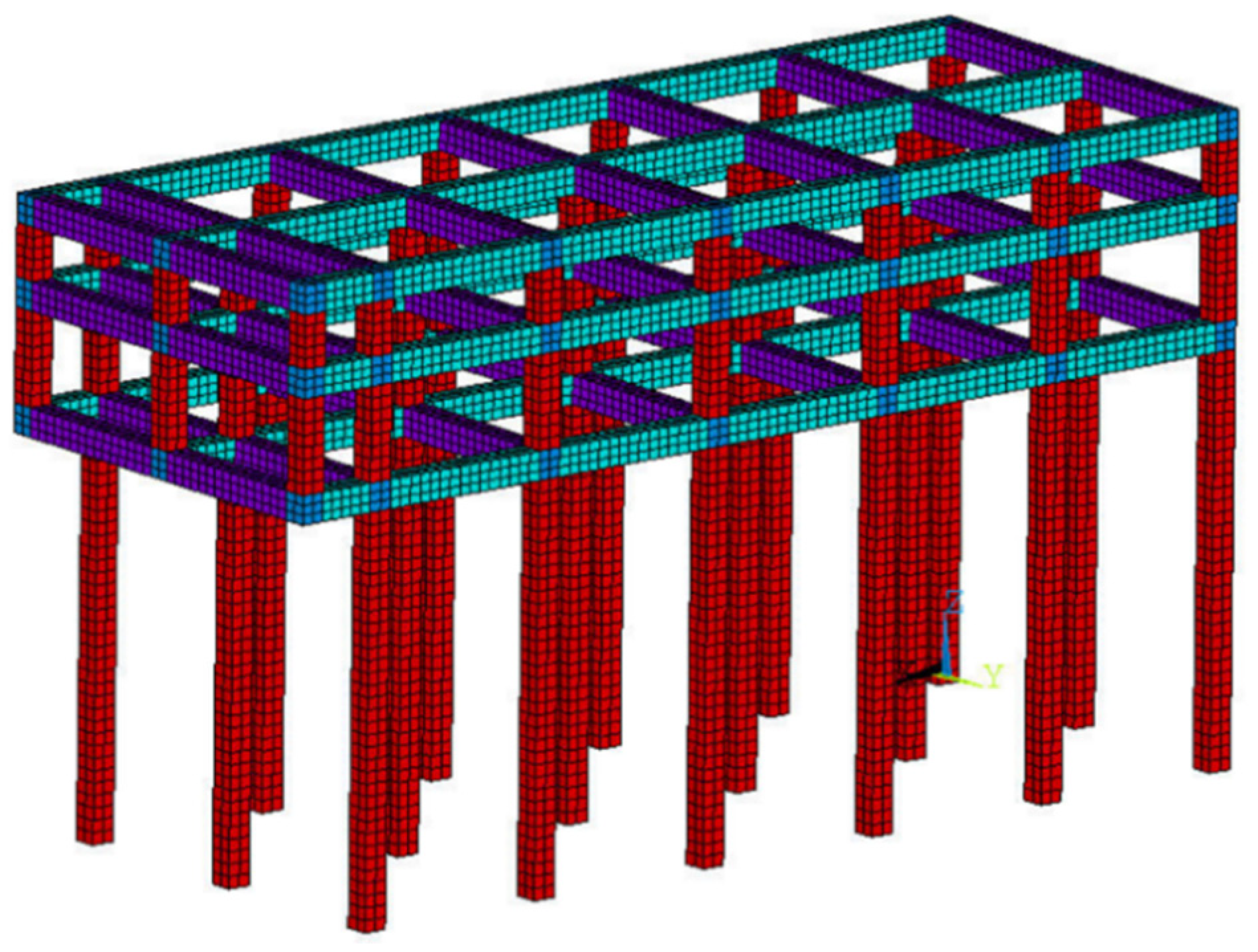
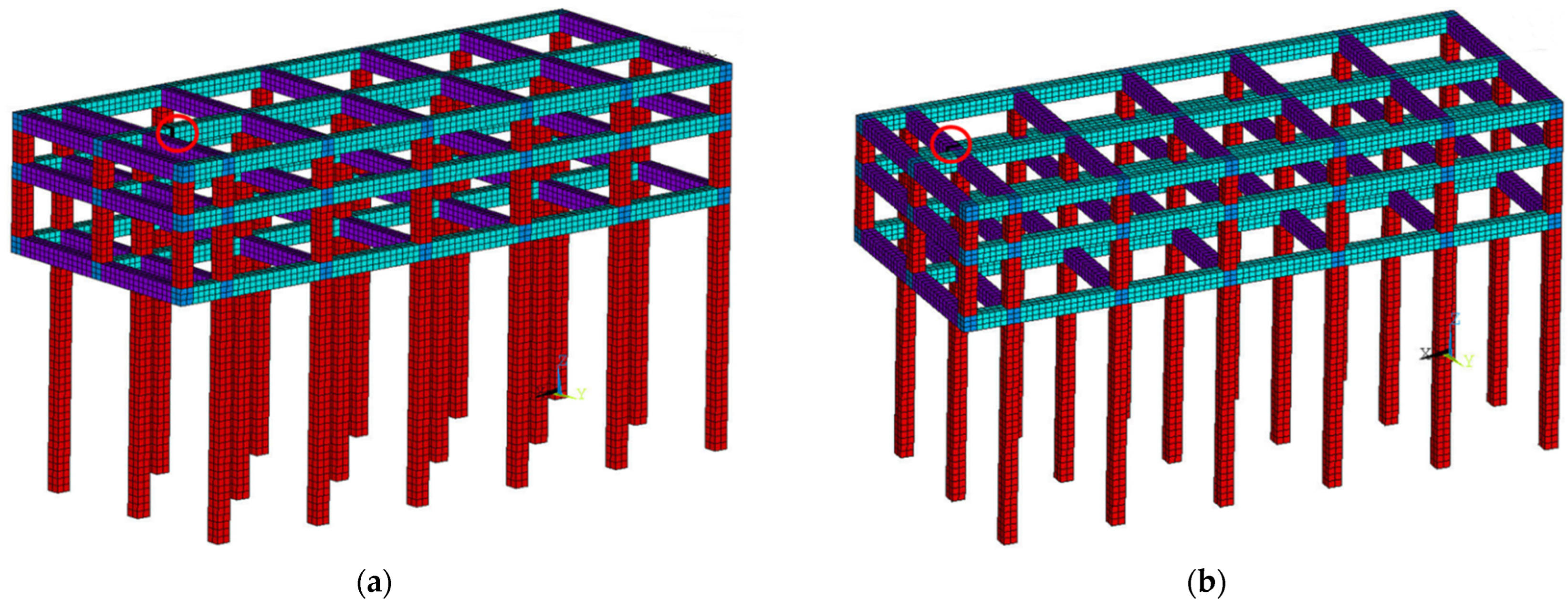
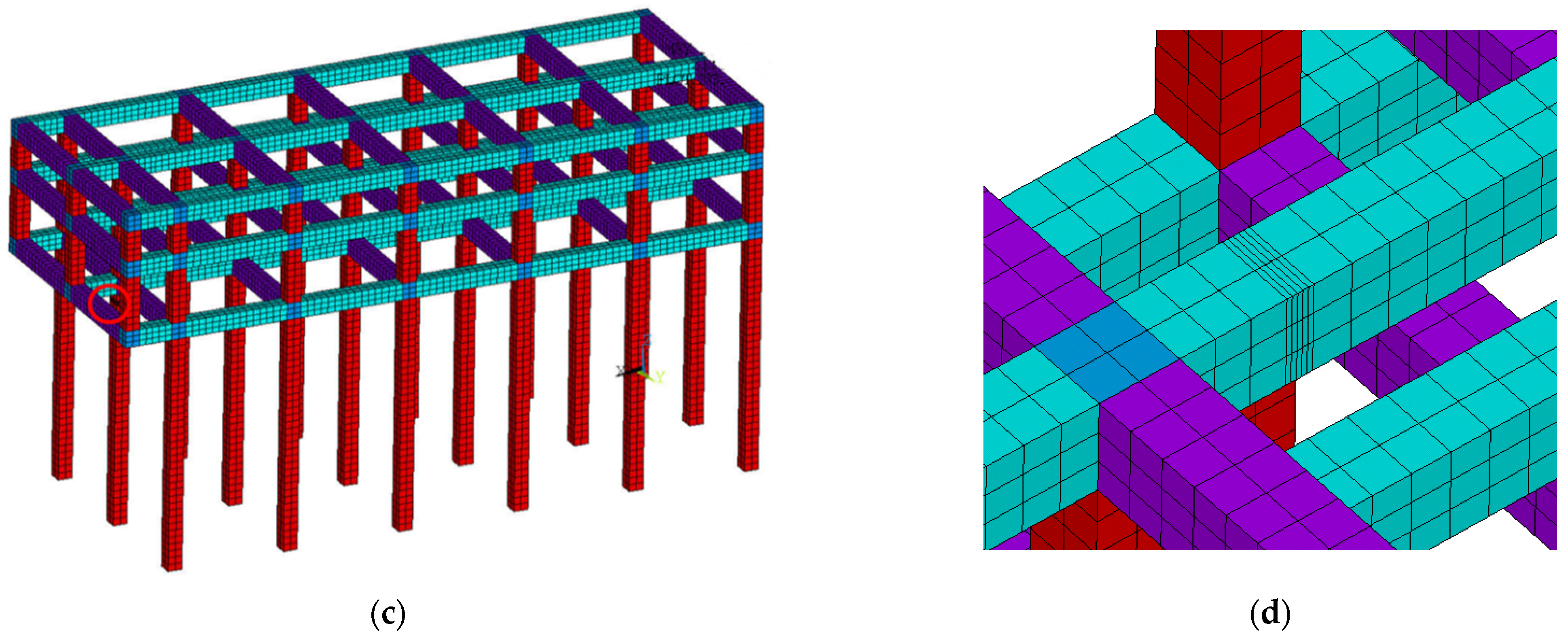
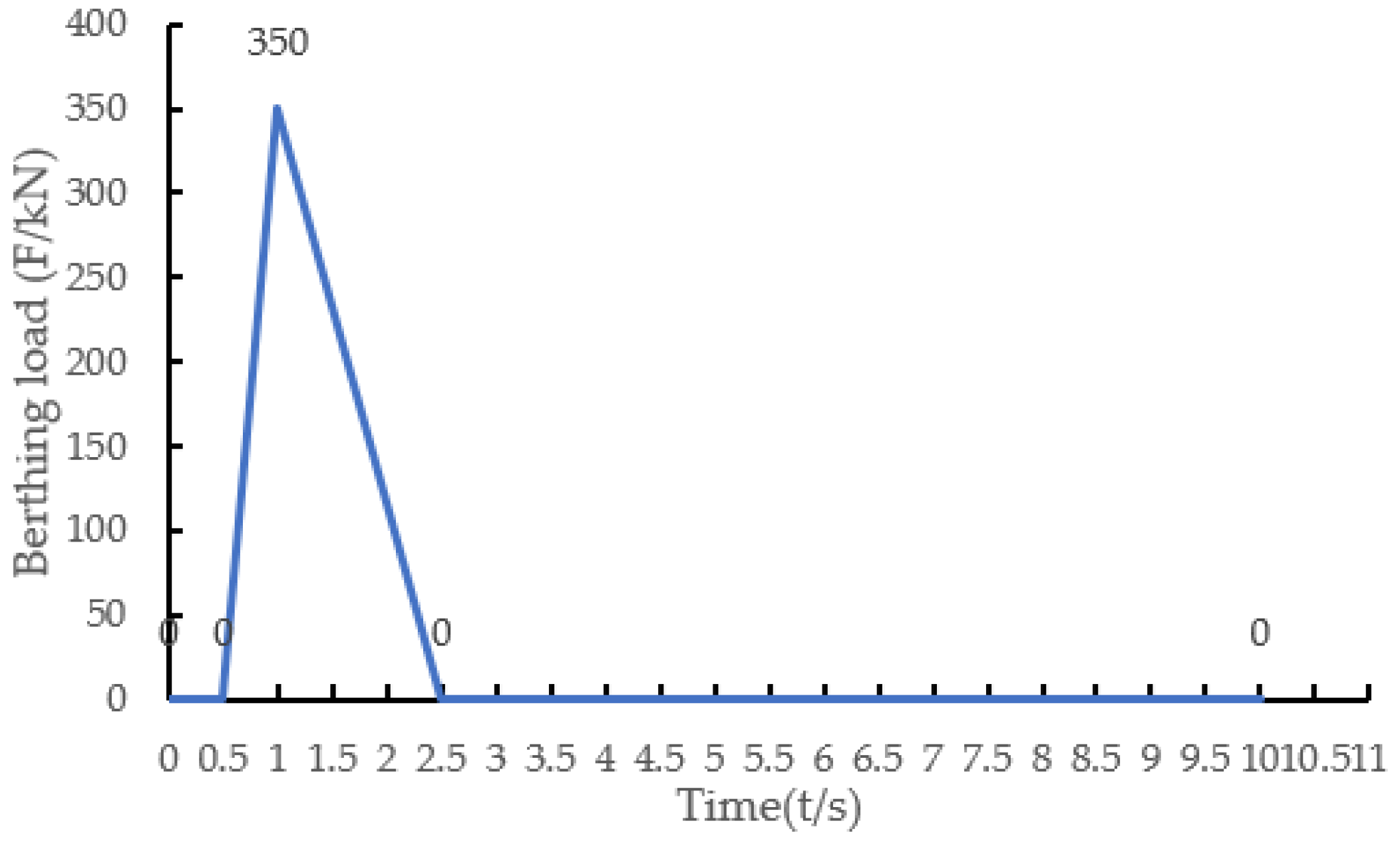
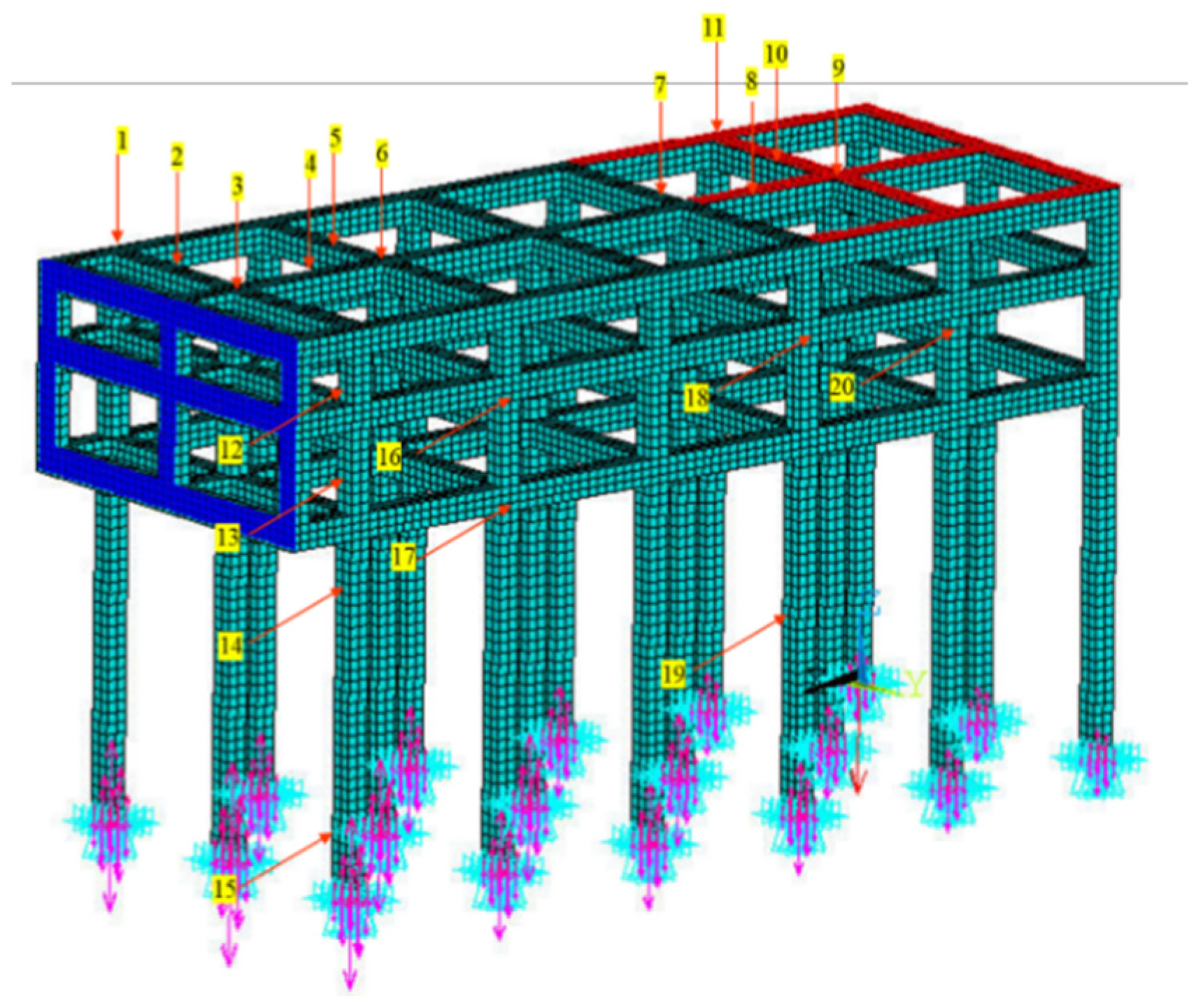
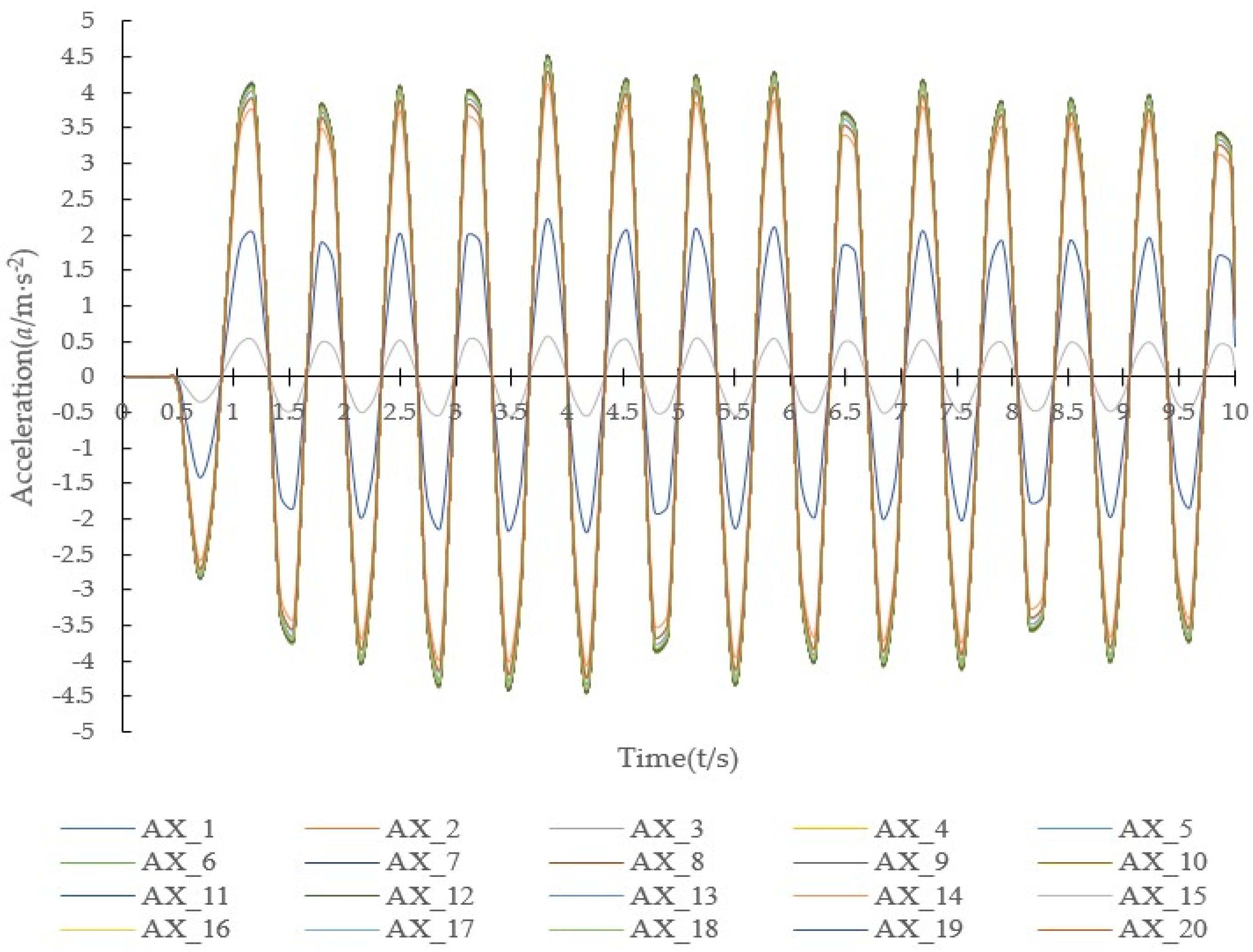
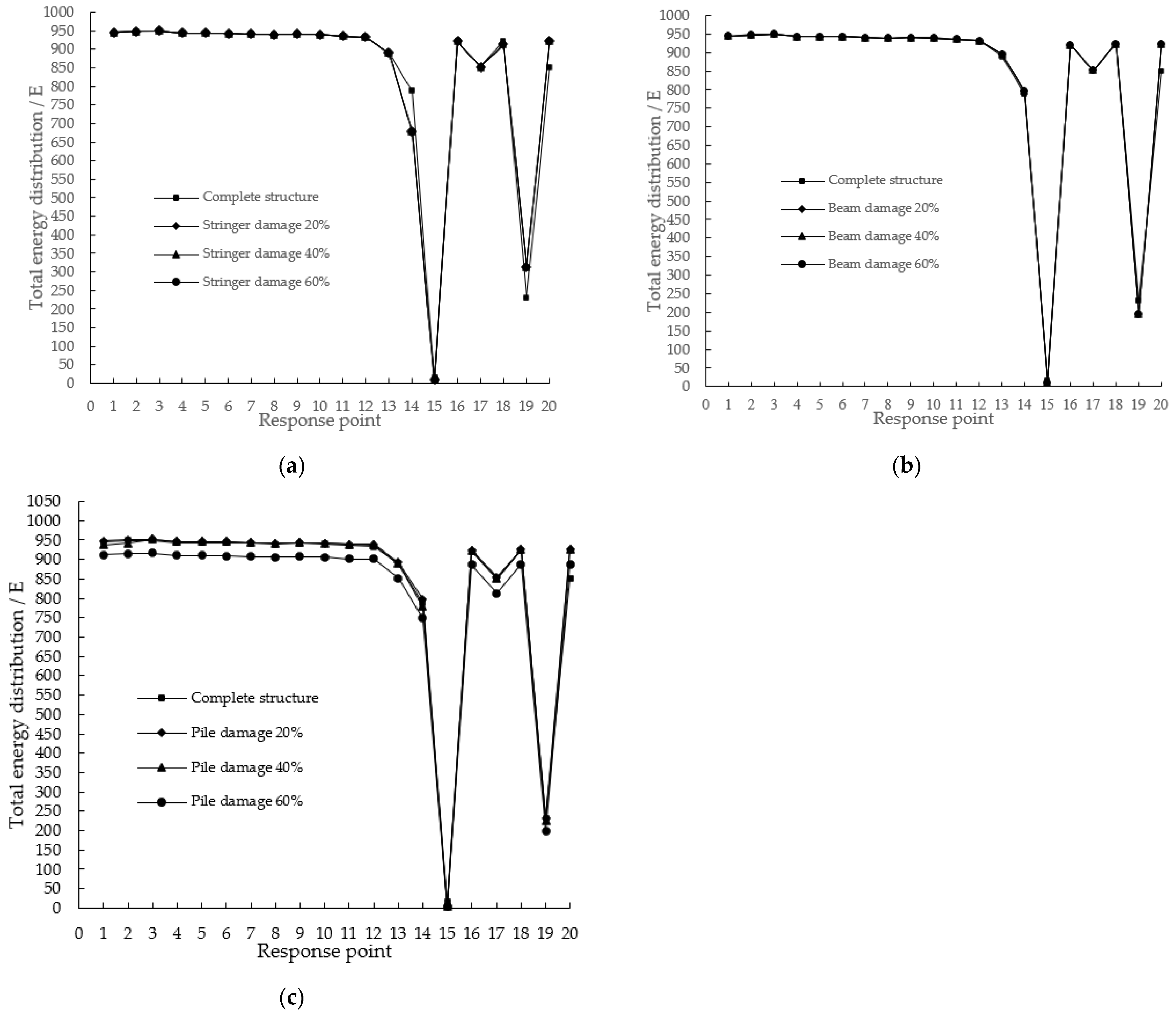

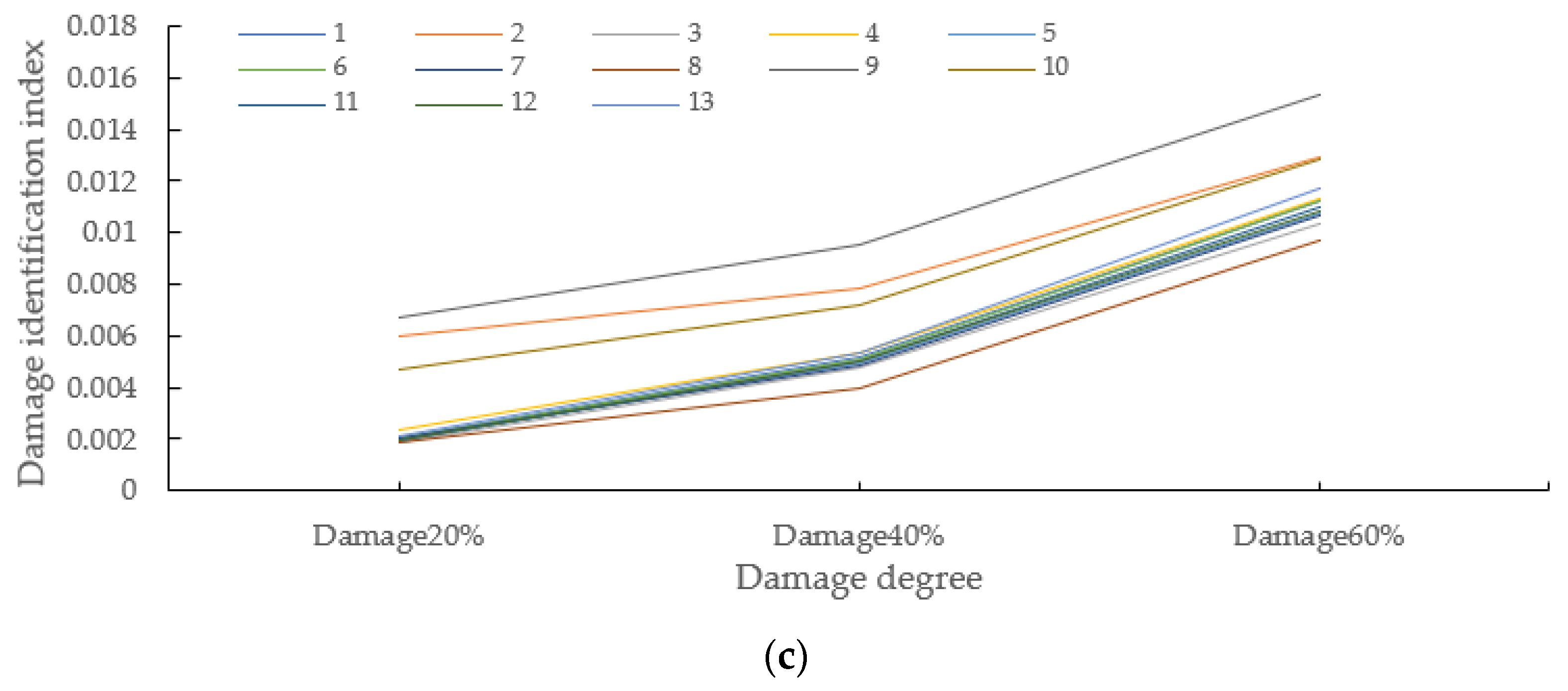
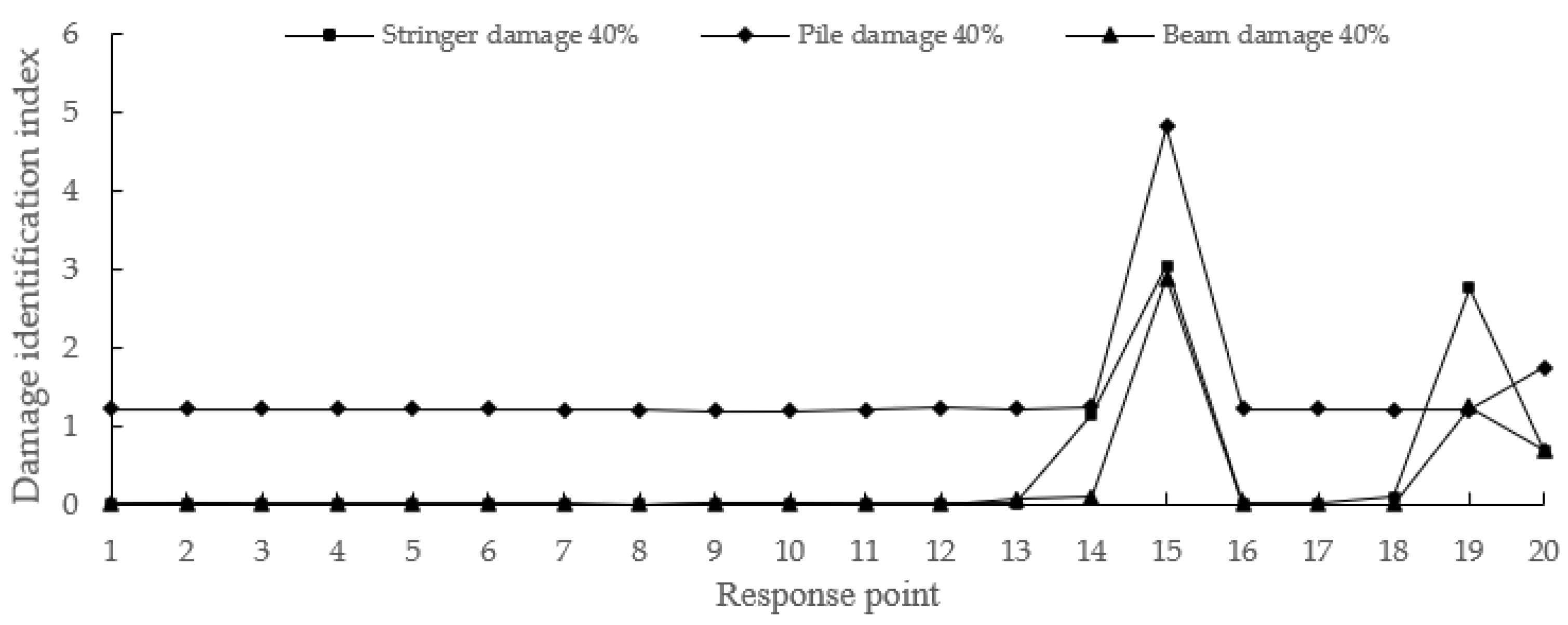
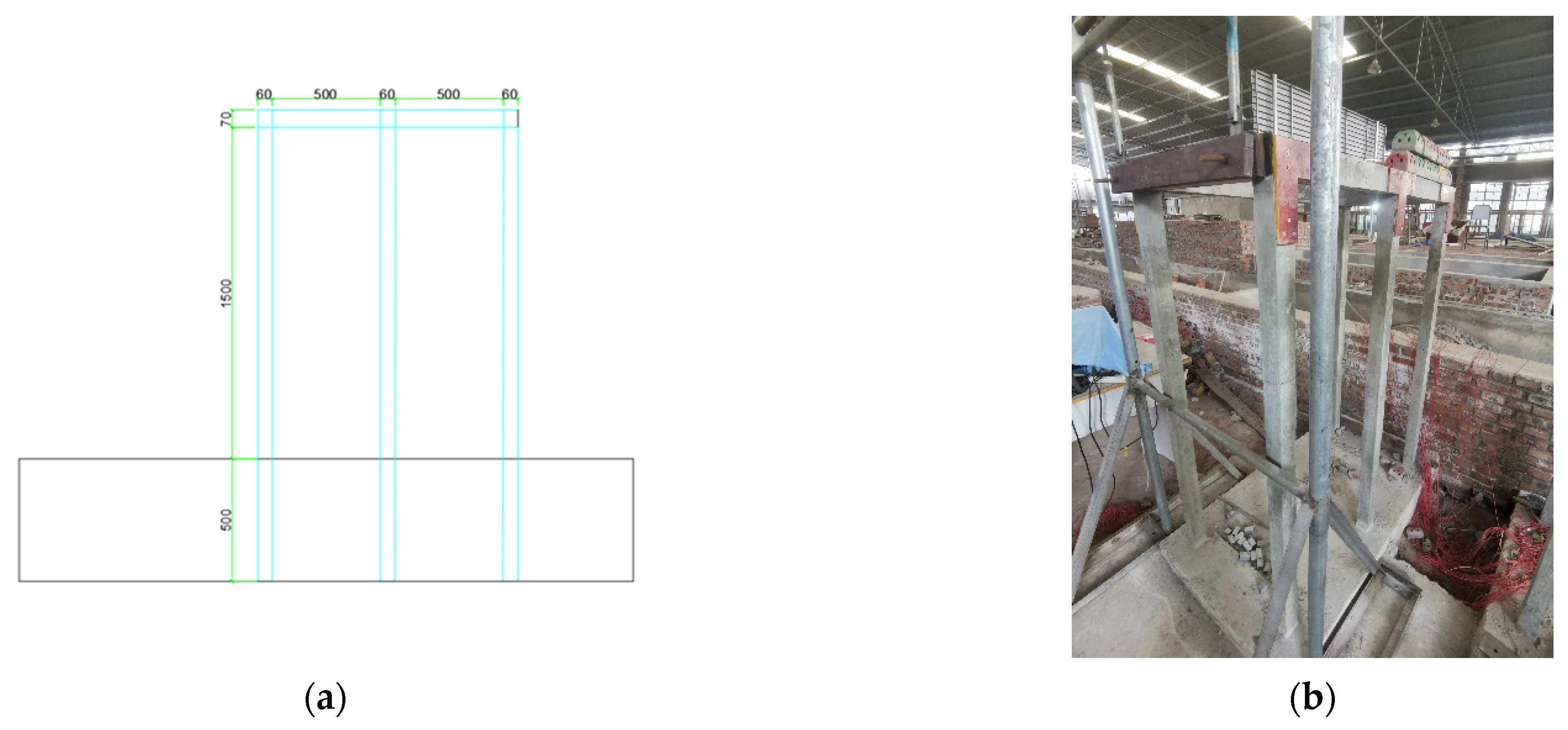
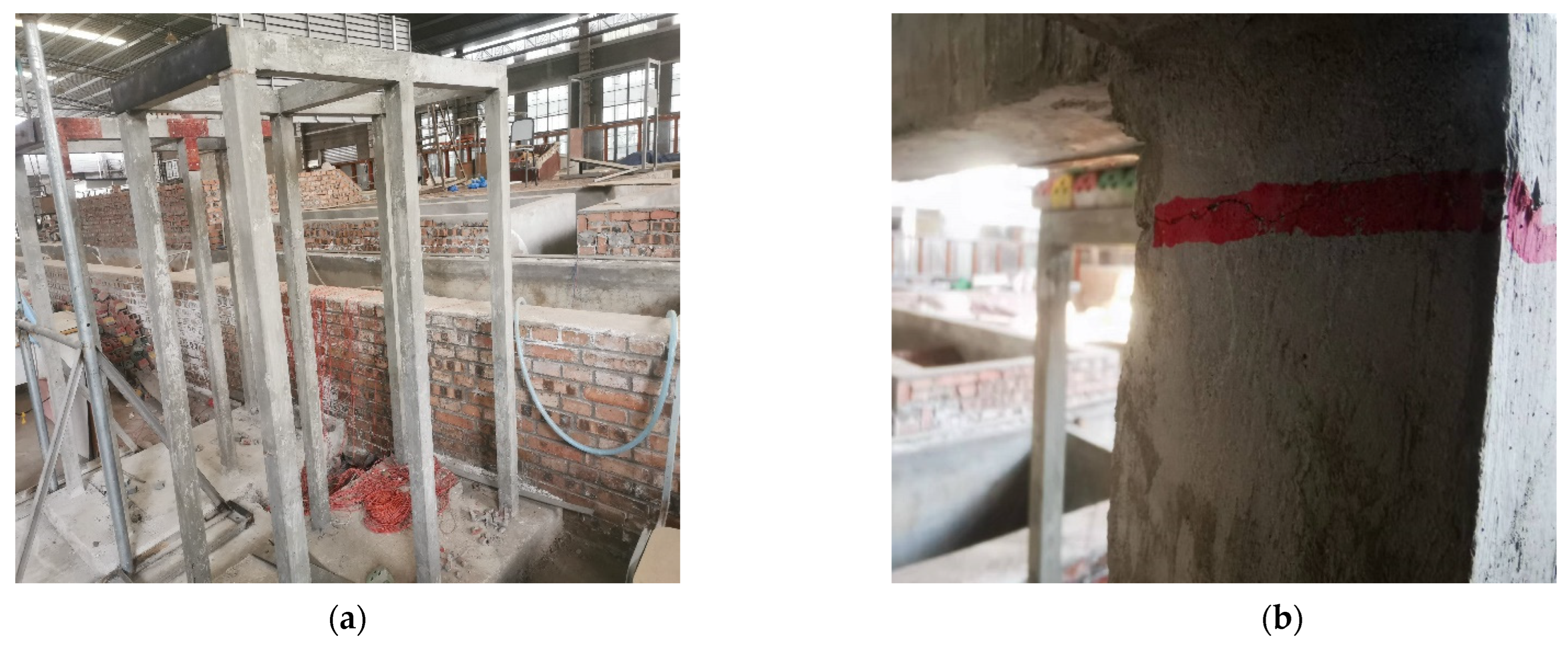
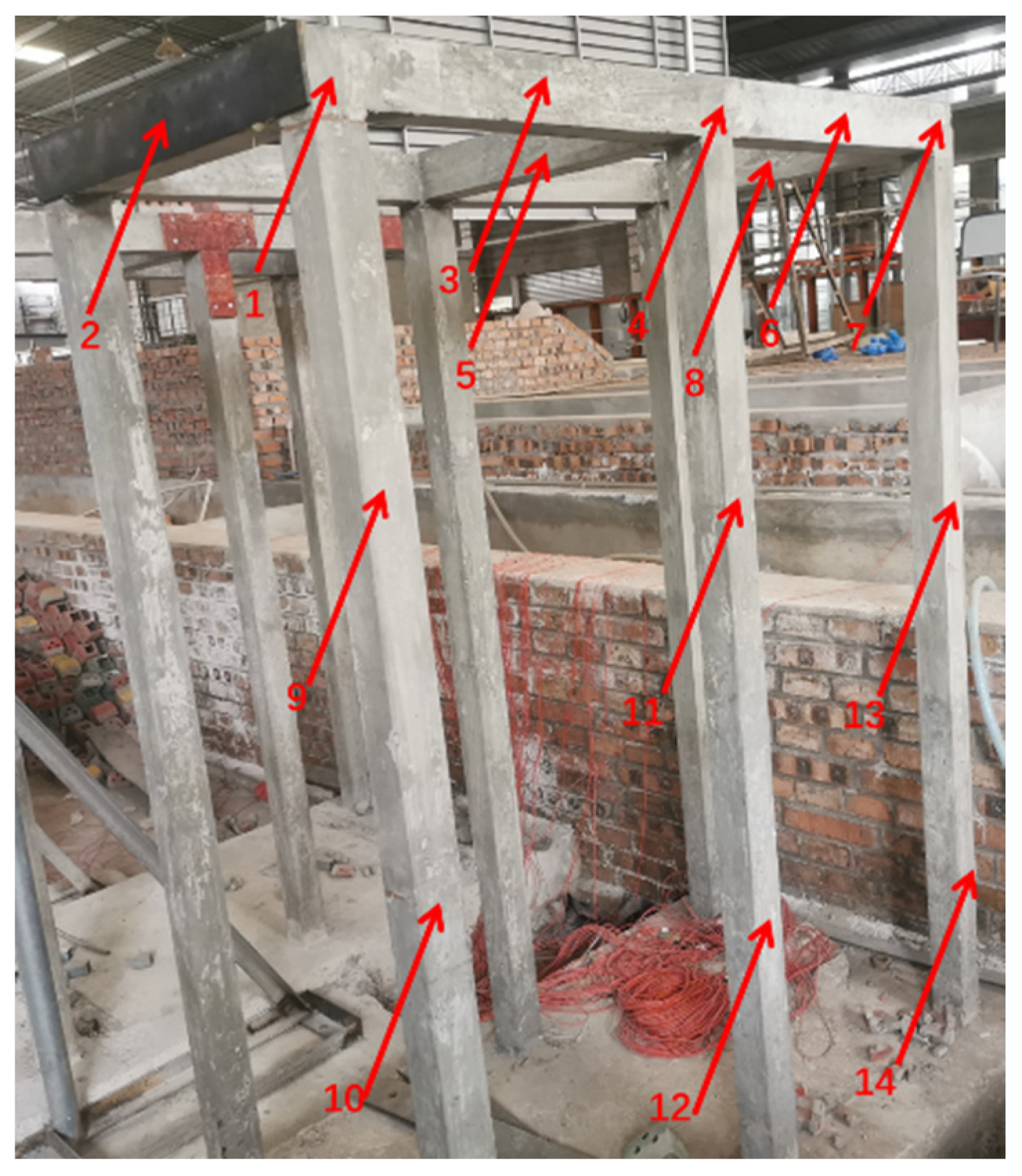
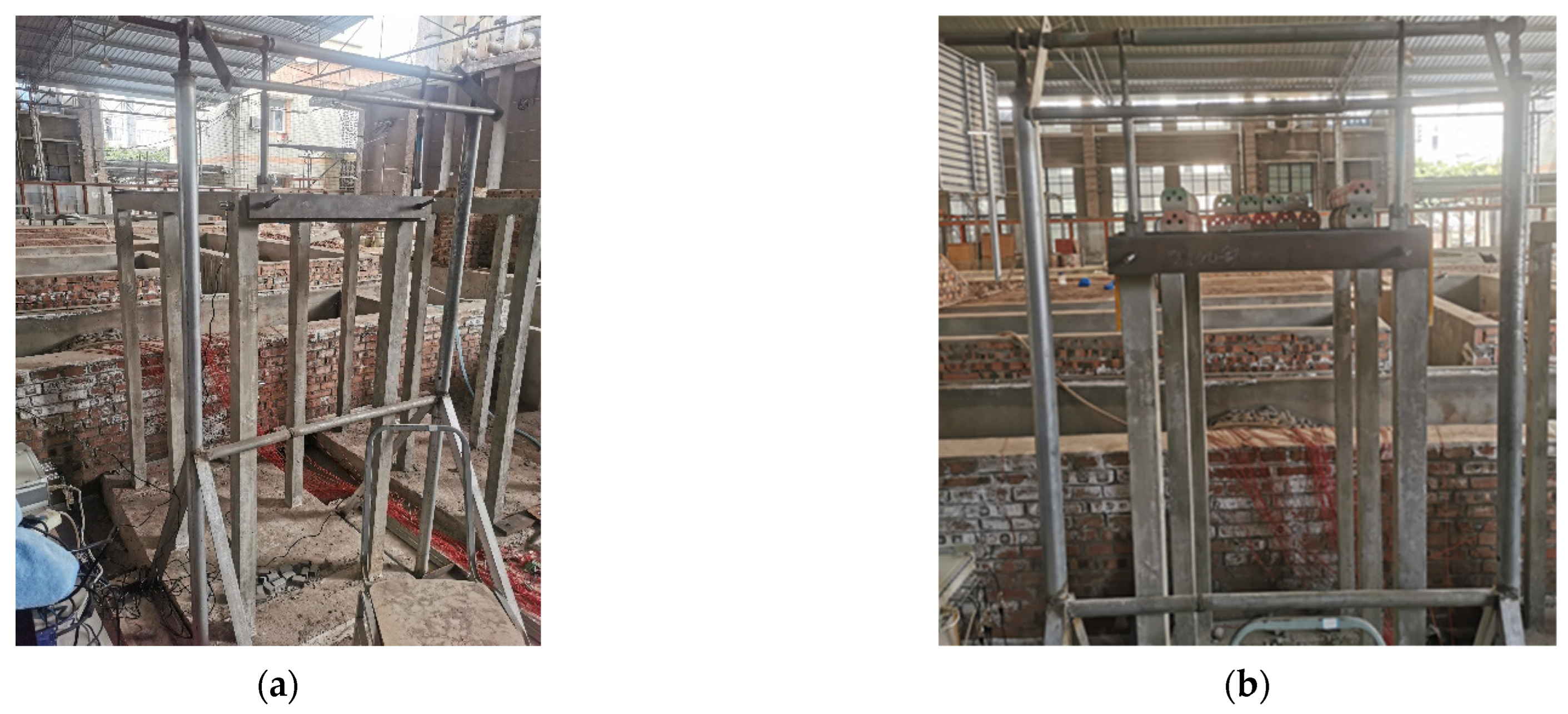

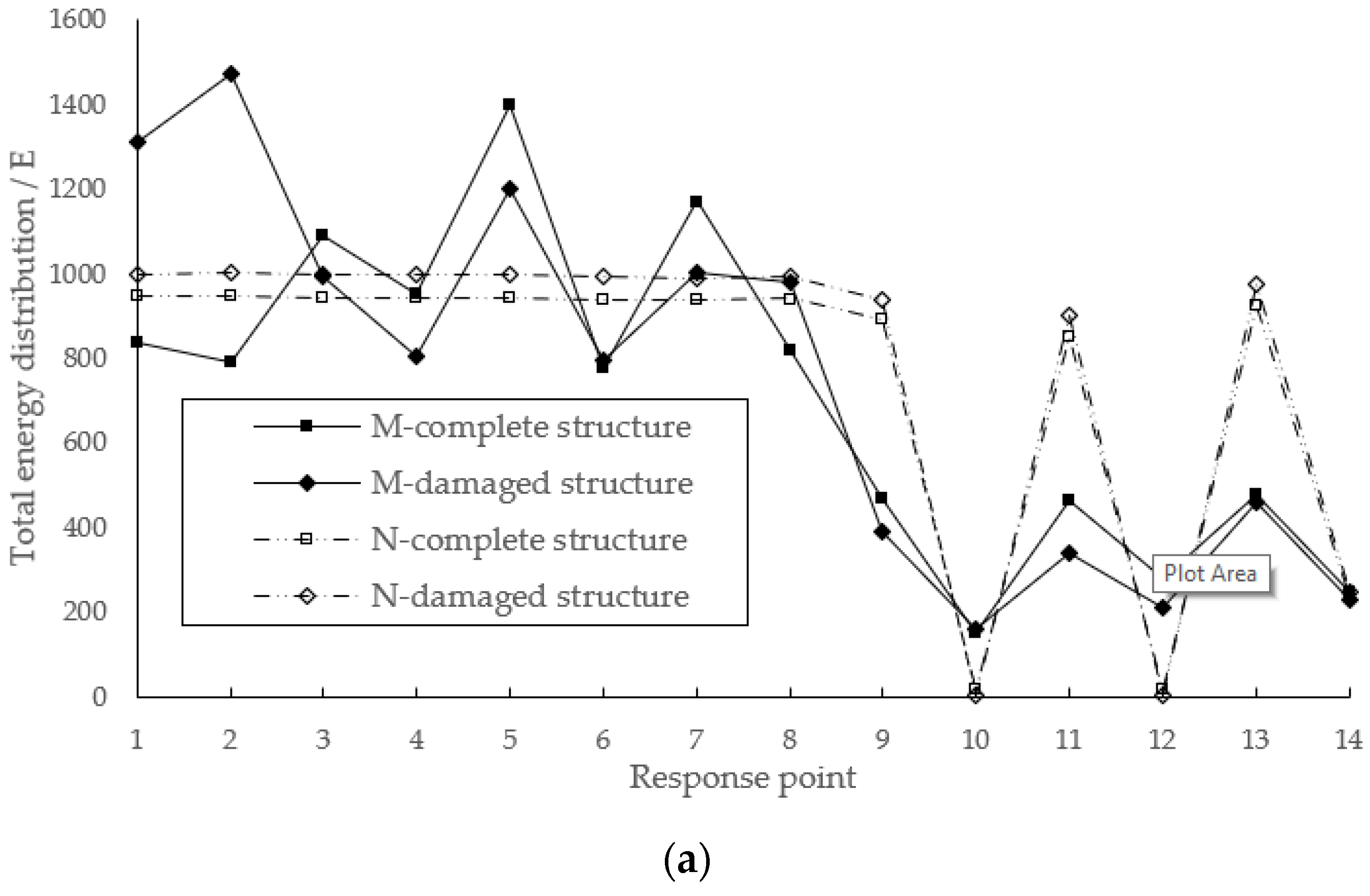
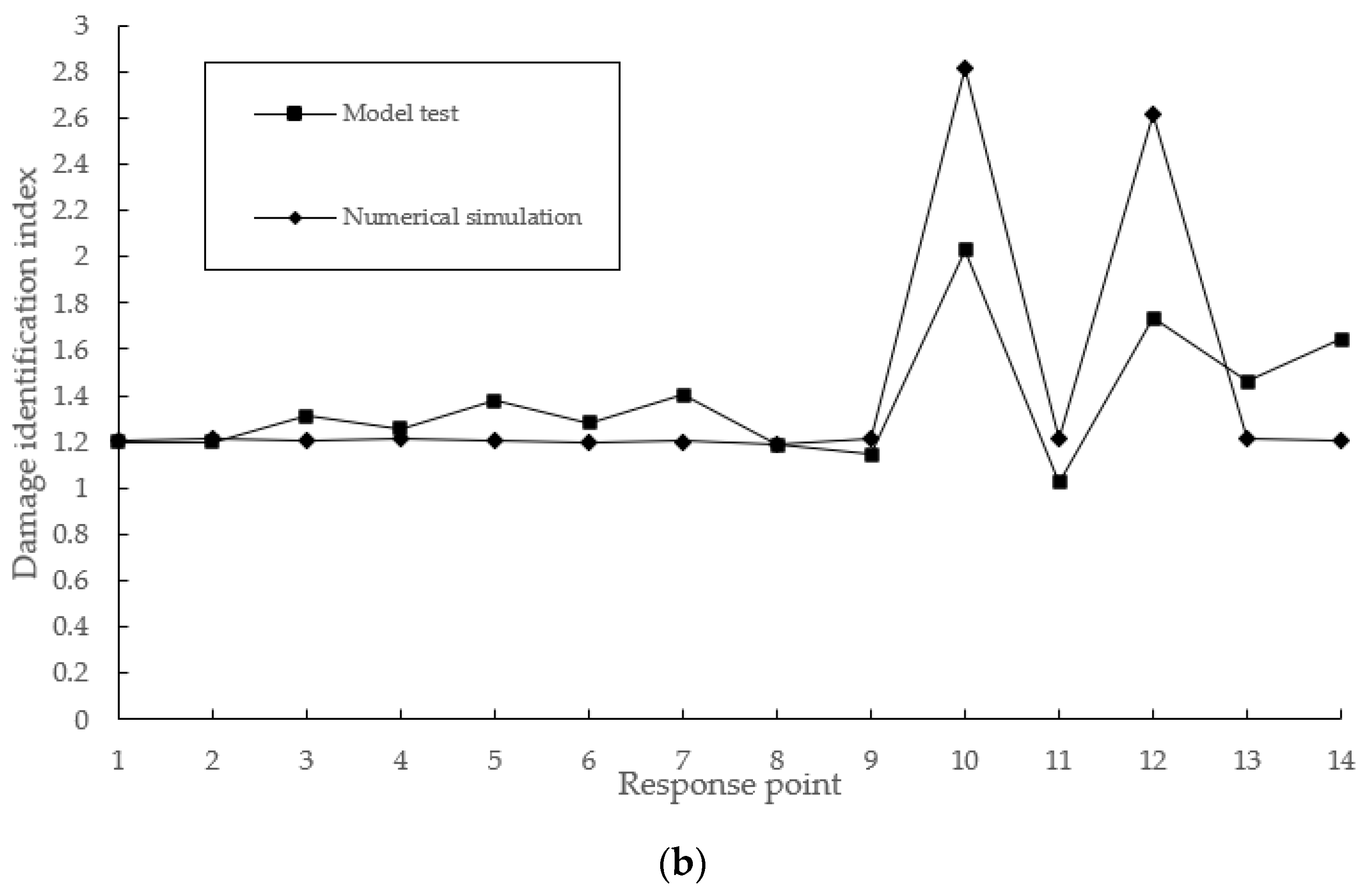
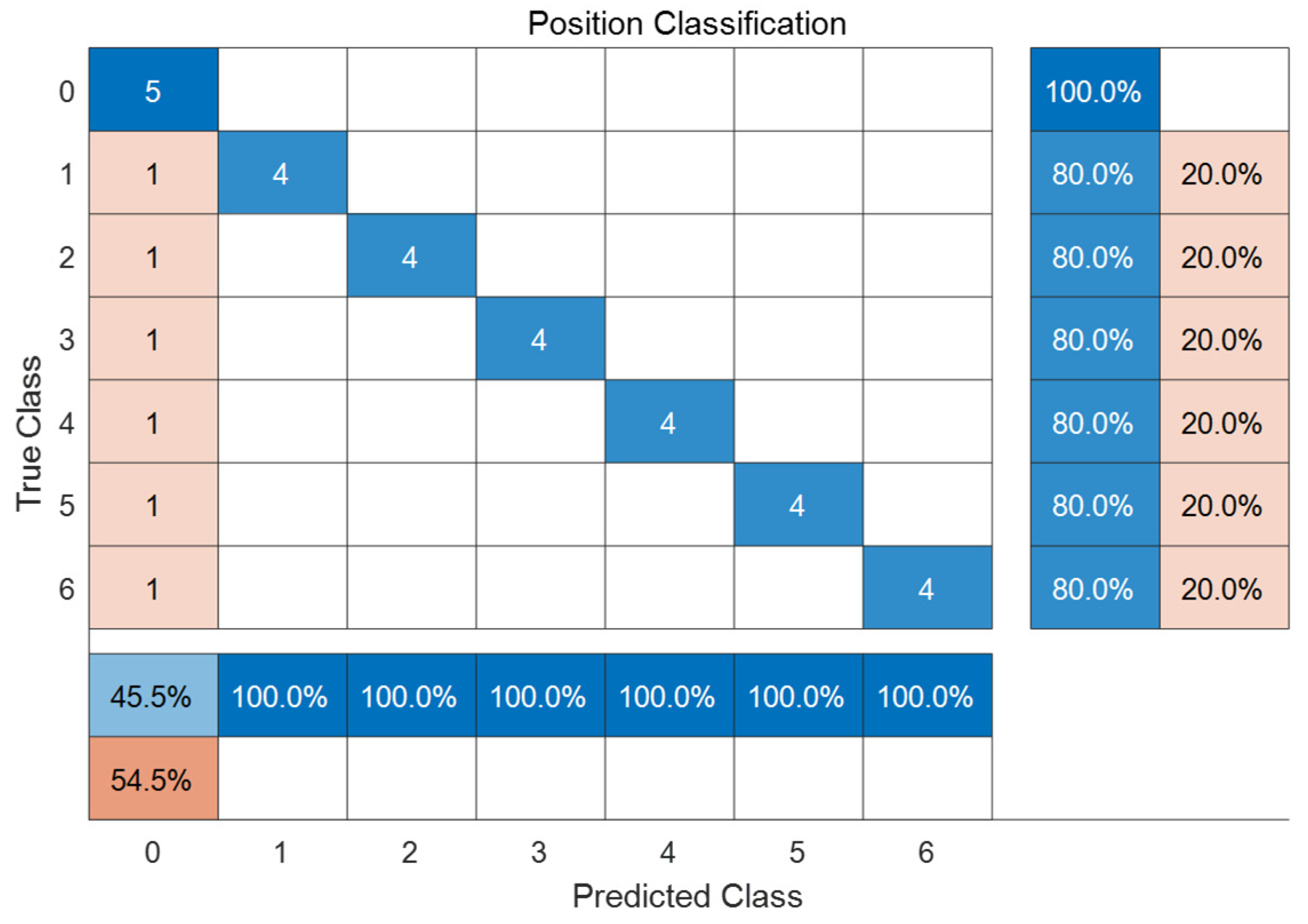
| Structural Part | Unit Weight (kN/m3) | Modulus of Elasticity (MPa) |
|---|---|---|
| Pile | 25 | 3.15 × 104 |
| Transverse girder | 25 | 3.15 × 104 |
| Bottom concrete | 24 | 3.05 × 104 |
| Hollow concrete block | 23.5 | 2.55 × 104 |
| Scheme | Test Conditions and Requirements | Load Combination |
|---|---|---|
| A |
| Dead weight + stowage load + dependent force |
| B |
| Dead weight + stowage load + dependent force |
Publisher’s Note: MDPI stays neutral with regard to jurisdictional claims in published maps and institutional affiliations. |
© 2022 by the authors. Licensee MDPI, Basel, Switzerland. This article is an open access article distributed under the terms and conditions of the Creative Commons Attribution (CC BY) license (https://creativecommons.org/licenses/by/4.0/).
Share and Cite
Zhao, M.; Wu, G.; Wang, K. Comparative Analysis of Dynamic Response of Damaged Wharf Frame Structure under the Combined Action of Ship Collision Load and Other Static Loads. Buildings 2022, 12, 1131. https://doi.org/10.3390/buildings12081131
Zhao M, Wu G, Wang K. Comparative Analysis of Dynamic Response of Damaged Wharf Frame Structure under the Combined Action of Ship Collision Load and Other Static Loads. Buildings. 2022; 12(8):1131. https://doi.org/10.3390/buildings12081131
Chicago/Turabian StyleZhao, Mingjie, Guoyin Wu, and Kui Wang. 2022. "Comparative Analysis of Dynamic Response of Damaged Wharf Frame Structure under the Combined Action of Ship Collision Load and Other Static Loads" Buildings 12, no. 8: 1131. https://doi.org/10.3390/buildings12081131
APA StyleZhao, M., Wu, G., & Wang, K. (2022). Comparative Analysis of Dynamic Response of Damaged Wharf Frame Structure under the Combined Action of Ship Collision Load and Other Static Loads. Buildings, 12(8), 1131. https://doi.org/10.3390/buildings12081131






